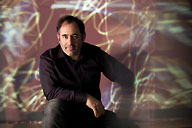Printed from www.flong.com
Contents © 2020 Golan Levin and Collaborators
Golan Levin and Collaborators
Bio
Biography (2010)

Golan Levin develops artifacts and experiences which explore the expressive use of computation. His work focuses on the design of systems for the creation, manipulation and performance of simultaneous image and sound, as part of a more general inquiry into the formal language of interactivity, and of nonverbal communications protocols in cybernetic systems. Through performances, digital artifacts, and virtual environments, often created with a variety of collaborators, Levin applies creative twists to digital technologies that highlight our relationship with machines, make visible our ways of interacting with each other, and explore the intersection of abstract communication and interactivity. Levin has exhibited widely in Europe, America and Asia.
Levin's work combines equal measures of the whimsical, the provocative, and the sublime in a wide variety of online, installation and performance media. He is known for the conception and creation of Dialtones: A Telesymphony [2001], a concert whose sounds are wholly performed through the carefully choreographed dialing and ringing of the audience's own mobile phones, and for interactive information visualizations like The Secret Lives of Numbers [2002] and The Dumpster [2006], which offer novel perspectives onto millions of online communications. Previously, Levin was granted an Award of Distinction in the Prix Ars Electronica for his Audiovisual Environment Suite [2000] interactive software and its accompanying audiovisual performance, Scribble [2000]. Other projects from recent years include Re:MARK [2002], Messa di Voce [2003], and The Manual Input Sessions [2004], developed in collaboration with Zachary Lieberman, and Scrapple [2005] and Ursonography [2005]; these performance and installation works use augmented-reality technologies to create multi-person, real-time visualizations of their participants speech and gestures. Levin has also developed projects, such as Opto-Isolator [2007] and Double-Taker (Snout) [2008], which employ interactive robotics and machine vision to explore the theme of gaze as a primary mode of human-machine communication.
Levin's work has been presented in the 2004 Whitney Biennial, the New Museum of Contemporary Art, the Kitchen, and the Neuberger Museum, all in New York; the Ars Electronica Center in Linz, Austria; The Museum of Contemporary Art in Taipei, Taiwan; the NTT InterCommunication Center (ICC) in Tokyo, Japan; and the Zentrum für Kunst und Medientechnologie (ZKM) in Karlsruhe, Germany, among other venues. His funding credits include grants from Creative Capital, The New York State Council on the Arts, the Pennsylvania Council on the Arts, the Rockefeller MAP Fund, The Greenwall Foundation, the Langlois Foundation, and the Arts Council of England.
Levin received undergraduate and graduate degrees from the MIT Media Laboratory, where he studied in the Aesthetics and Computation Group. Between degrees, he worked for four years as an interaction designer and research scientist at Interval Research Corporation, Palo Alto. Presently Levin is Co-Director of the Frank-Ratchye STUDIO for Creative Inquiry and Professor of Electronic Time-Based Art at Carnegie Mellon University, where he also holds Courtesy Appointments in the School of Architecture, School of Computer Science, and the School of Design.
Press photographs and headshots:
Other versions and biographic resources:
- Alternate biographies (English)
- Flickr archive of additional press photographs and headshots
 Deutsche Zusammenfassungen von Hauptprojekten
Deutsche Zusammenfassungen von Hauptprojekten Deutsche
Deutsche Français
Français Italiano
Italiano Español
Español Hollands
Hollands Portugues
Portugues Slovenčina
Slovenčina Japanese
Japanese Korean
Korean Chinese (Simplified)
Chinese (Simplified) Czech
Czech




